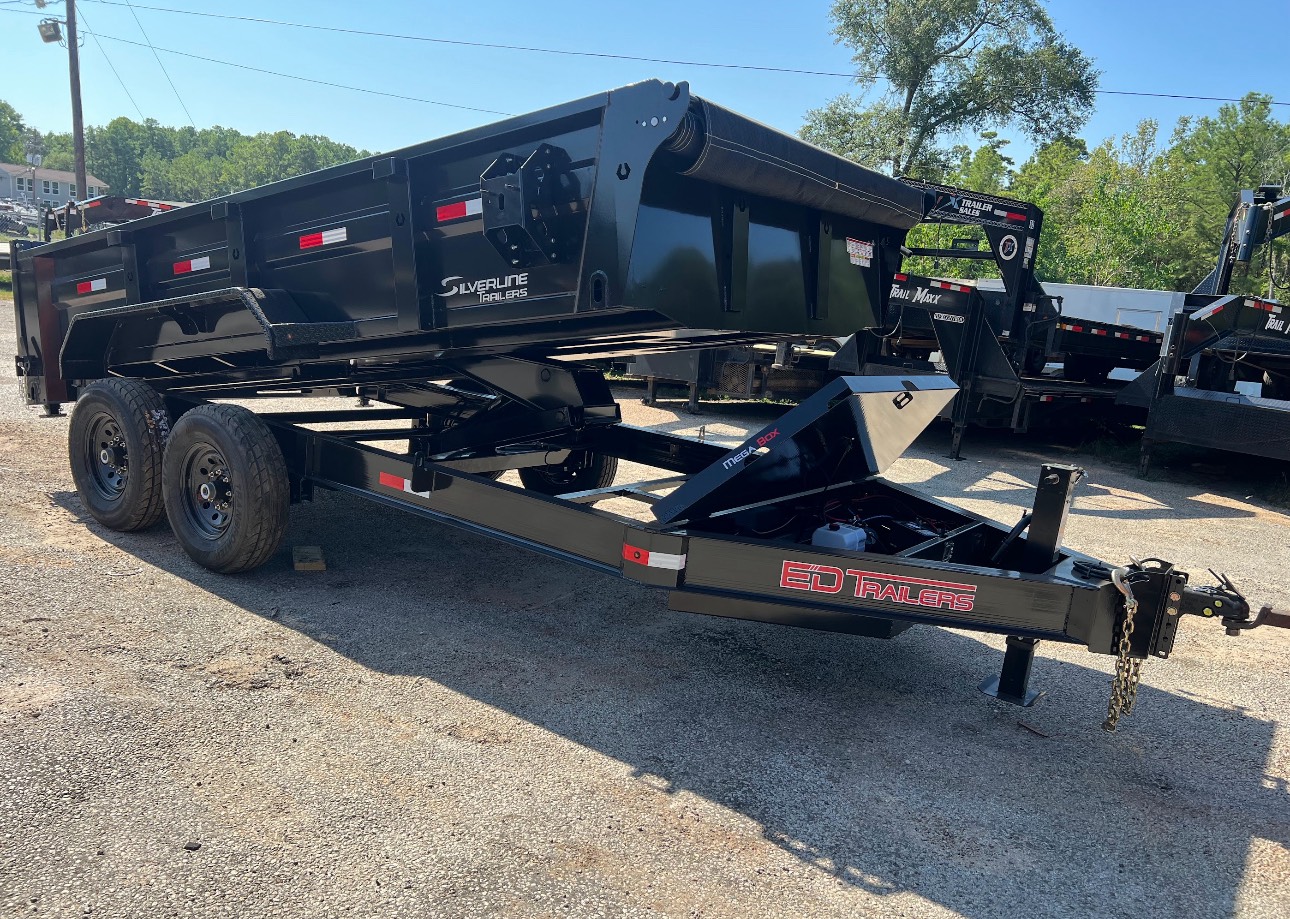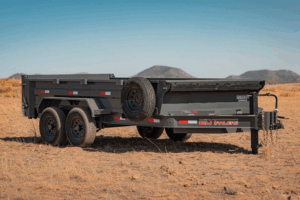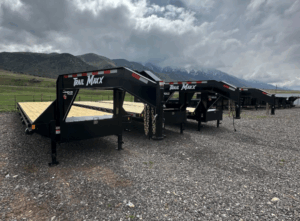Thinking about a new trailer. It’s a big step, and whether you’re growing your landscaping business, heading out with your ATVs for the weekend, or you’re a pro moving serious weight, there’s one key choice you’ll face. And that is the single axle versus tandem axle debate. Getting this right can really save you from headaches, lost time, and unexpected costs down the road.
Picking the perfect trailer isn’t just about what looks good. It’s about making sure the weight it can handle and its design are a perfect match for exactly what you need to haul. This guide is here to really dig into the key differences between single and tandem-axle trailers. Our goal is to give you the information you need to pick the absolute best fit for your own life and any business you might have.
What’s the Difference Between Single and Tandem Axle Trailers?
The basic setup of the trailer makes a world of difference in how it handles and what you can actually haul. A single-axle trailer has just one set of wheels, and that comes with its own set of benefits. A typical single-axle trailer can pull anywhere from 2,000 to 5,000 pounds.
Tandem axle trailers, sometimes called a double axle or tandem trailer, is a trailer with two sets of wheels. This design change has a huge impact on things like how steady it is, how long it lasts, and how easy it is to move around, especially when you’re carrying heavier stuff.
Single Axle Trailers
If you prefer a trailer that is light-weight and easy to handle, that’s essentially what you get with a single-axle trailer. It rolls on just one trailer axle and a single set of wheels, making it a surprisingly capable option for all sorts of jobs.
Because they’re generally smaller and lighter, these trailers are much simpler to hook up and tow, even with a smaller vehicle. Plus, the smaller frame of these trailers often means you’ll save a bit on gas money too.
Exceptional Maneuverability
If there’s one thing a single axle trailer truly excels at, it’s moving through tight spots. Its more compact size gives it a seriously impressive turning radius. This means you can weave it into challenging areas like crowded construction sites or residential driveways with surprising ease.
It’s the perfect companion for so many jobs and can work as an excellent utility trailer for homeowners tackling weekend projects, landscapers just starting out, or weekend adventurers who want to take a small ATV out for some fun.
Lower Cost and Maintenance
Beyond its easy maneuverability and versatility, the single axle design also tends to be less expensive than tandem axle trailers. You’ll usually find them at a lower price point when you buy, and over the long haul, your maintenance costs should stay pretty low. The reason is pretty simple, as there are fewer parts on these trailers to worry about or replace down the line.
Understanding Weight Limits
While a single axle trailer is fantastic for all kinds of smaller tasks, it’s crucial to understand its limits. These trailers are built with a specific weight capacity in mind, and they aren’t really meant for consistently hauling heavy loads or tackling really long distances. Generally speaking, a single axle trailer is happiest carrying a payload of around 3,000 to 3,500 pounds.
Handling a Flat Tire
One last thing to keep in mind is what happens if you get a flat. With only one axle, if a tire goes, the entire side of your trailer will dip down significantly. It’s not the end of the world, but it definitely makes dealing with the situation a bit more challenging as the weight shifts dramatically.
Tandem Axle Trailers
When your hauling needs involve truly heavier loads or regular trips over long distances, a tandem axle trailer often emerges as the clear better option. These trailers, sometimes referred to as double axle or tandem trailers, are designed with two trailer axles and usually feature four sets of wheels. This setup immediately translates into a significantly higher load capacity and enhanced durability for just about any demanding job you throw its way.
Unmatched Stability and a Smoother Ride
One of the biggest perks of a tandem axle trailer is the way it distributes the trailer’s weight across those two axles. This means you experience a much smoother ride and a noticeably more balanced feel while on the road.
This is especially noticeable on rough roads, uneven terrain, or when encountering unexpected potholes. The second axle can genuinely absorb a lot of the impact, leading to a far less jarring driving experience. This design also contributes to much better stability, even at higher speeds.
Enhanced Safety Features
Beyond comfort, the dual-axle design provides an important layer of safety and peace of mind. If one tire goes flat on the road, the other three tires can still effectively support the payload. This gives you precious extra time to safely guide your tow vehicle and trailer to the side of the road rather than facing an immediate, urgent stop.
Plus, many tandem axle trailers come equipped with electric brakes as standard. These braking systems offer powerful stopping ability, which is a crucial safety feature when you are managing a heavy payload or heavy equipment.
Built for Serious Hauling
If you are a professional hauler or simply need to move serious heavy equipment or heavier cargo, a tandem axle trailer is truly built for heavy-duty hauling. Its entire construction is geared towards handling substantial weight with remarkable ease, whether you are going a few miles or traversing long distances.
While it is true they generally offer less maneuverability and a wider turning radius compared to a single axle trailer, the superior stability and dramatically increased weight capacity make them the undeniable choice for serious hauling needs.
Considerations for Maintenance
It is important to note that with more components, you can expect slightly higher maintenance costs for a tandem axle trailer. There are more tires, wheels, and parts to service and potentially replace over its lifetime.
Side-by-Side Comparison Between SIngle and Tandem Axle Trailers
Alright, so you’re weighing your options, trying to nail down the right trailer for what you need to get done. Let’s put a single axle and a tandem axle trailer side-by-side and see how they stack up. It’s really about figuring out which one is the best partner for your specific hauling needs.
When Weight Matters Most
The amount of weight you need to move is usually the top priority when deciding between a single or tandem axle trailer. A single-axle trailer is your buddy for lighter loads. We’re talking a payload that’s generally happiest under around 3,500 pounds. Think of grabbing a couple of ATVs for a weekend escape or hauling a modest pile of landscaping supplies.
But when those loads get serious, or you’re moving heavy equipment, the tandem axle trailer steps up. Its whole design screams “heavy-duty,” giving you a much higher load capacity built specifically for substantial hauling needs and heavier cargo.
Where Are You Taking Your Trailer?
Now, consider where you’ll be taking this trailer. A single-axle trailer is way easier to maneuver, especially when you’re squeezed for space. That single trailer axle gives it a super tight turning radius, making it way easier to swing into tricky driveways or weave through a busy job site. The tandem axle trailer, with its two axles, has a wider turning radius. It’s less nimble and can be a bit more of a wrestling match when you’re trying to back up, particularly in really tight spaces.
The Feel of the Road
The actual towing experience is pretty different, too. Pulling a single-axle trailer can sometimes feel a little less planted, especially if the road is rough or you’re cruising at higher speeds. All that trailer weight is concentrated on one axle, and you might feel every bump and dip more acutely.
A tandem axle trailer, on the other hand, spreads the load across two axles. This means you get a noticeably smoother ride and a big boost in stability. Plus, there’s that extra peace of mind. If one tire decides to call it quits, the other three are still there to support your payload, buying you precious time to find a safe spot to pull your tow vehicle and trailer over.
Long Term Value
Generally, a single-axle trailer will have a lower sticker price when you buy it, and you can expect lower long-term maintenance costs. It’s just got fewer parts like tires, wheels, and bits of suspension to keep an eye on or replace.
A tandem axle trailer is a bigger initial investment, and you’ll likely see slightly higher ongoing maintenance costs because, well, there are simply more tires, wheels, and components that need regular attention.
Let Silverline Trailers Help You Choose
Making the right choice for your trailer can feel like a big decision, but you do not have to go it alone. At Silverline Trailers, we pride ourselves on helping people find trailers that accommodate all of their top priorities. We have a wide selection of both single axle trailers and tandem axle trailers, and our team is ready to walk you through all the options to match your lifestyle and hauling needs.




